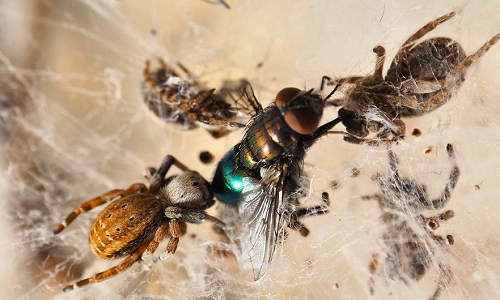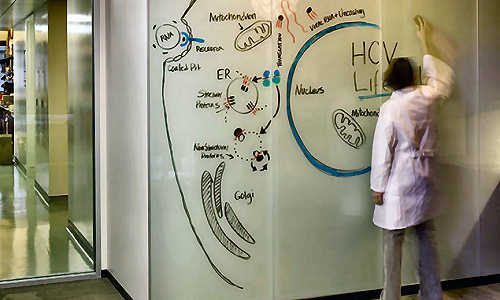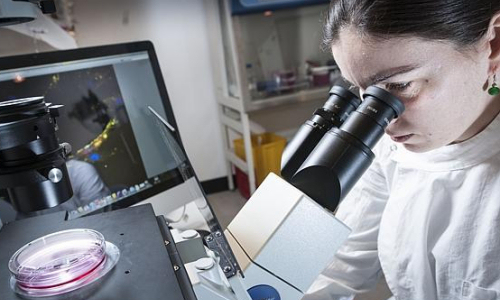For the first time ever, a group of Danish and Chinese researchers has sequenced the genome of the spider. This knowledge provides a much more qualified basis for studying features of the spider. It also shows that humans share certain genomic similarities with spiders.
The velvet spider’s genome has now been mapped. This image shows a group of social velvet spiders jointly killing their prey. Photo Credits: Peter Gammelby, Aarhus University.
The fact that the eight-legged creepy spider in some ways resembles humans is one of the surprising conclusions after researchers at Aarhus University and the Beijing Genomics Institute (BGI) succeeded in sequencing its genome.
However, it is more a discovery on an awesome scale. The sequencing has far greater significance for our future understanding of the spider’s special properties
“In brief, we’ve acquired a tool for everyone interested in spiders,” say Kristian W. Sanggaard and Jesper S. Bechsgaard, Aarhus University. Together with Xiaodong Fang, BGI, they are the first authors of the study, which has been published in Nature Communications. By describing the spider genome, the researchers have roughly speaking drawn up its genetic map. This map can be used in future to navigate to and delve into different areas of the spider’s functions – which will now be easier to describe.
What is a spider?
The researchers worked with two types of spiders, representing two of the three main groups in the spider family. One of these is a small velvet spider and the other is a tarantula.
The researchers succeeded in sequencing the velvet spider’s genome, while there are still some unsolved gaps in the genetic map of the tarantula.
“The idea was that, by comparing their genetic makeup, we’d try to see whether we could say anything in general terms about what makes a spider a spider,” says Kristian W. Sanggaard. However, it is almost 300 million years since the two types of spiders had a common ancestor, so the researchers could only find a limited number of similarities. “But we found a number of genes – about two to three hundred – that have only been found in these two types of spiders and not in other organisms. They could be candidates for genes specific to spiders,” says Jesper S. Bechsgaard.
From overview to insight
The researchers were not content with simply mapping the spider genome. They also looked at the protein composition of two of the most interesting areas of the ‘crawly cousins’ – silk and venom production. By including the proteins, they did not restrict themselves to providing a map, but they also filled in details on two specific points. James Watson, who was awarded a Nobel Prize for describing the structure of the DNA strand, called genes the ‘script’ and proteins the ‘actors’. By describing the proteins, the researchers thus demonstrated so to speak that their script works. Or – to keep to the map analogy – that the genetic map actually leads in the right direction. This is one of the only studies in which the proteins are described along with the genome. This was possible because the Aarhus researchers have some of the most advanced mass spectrometry equipment in the world for sequencing large numbers of proteins.
We can learn from spiders
The spider is a fantastic hunter. With the aid of its web, it can catch prey that are several times larger than itself, and it can also use its venom to subsequently kill the prey. Many researchers all over the world would like greater insight into areas such as how it makes its silk of thin, but incredibly strong thread, and how its venom works. By understanding the underlying mechanisms, we will possibly be able to convert this to industrial use in the long term, for purposes such as manufacturing biomaterials or developing medicine and pesticides. By describing the genome, the researchers have acquired a much better tool than they previously had for studying spiders. “People can select an aspect or feature of the spider they’re interested in, and then utilise the ‘genetic map’ we published and which we ourselves have used to study silk and venom. This provides completely new opportunities for spider researchers,” say the two Aarhus researchers. They personally intend to use the genome for further work with studies of the spider’s digestive enzymes and immune system.
Story Source:
The above story is based on materials provided by Aarhus University.






